A Solution to Blue Apron’s Retention Problem
Once upon a time, Blue Apron flourished as a promising unicorn startup. Backed by $135 million in venture funding and a $2 billion valuation, the company was primed to become the ultimate disrupter of the food and grocery industry.
Fast forward to today, and the company has found itself in a different reality:
“We have a history of losses, and we may be unable to achieve or sustain profitability.”
– Blue Apron, August 2019
Where did things go wrong? Why didn’t Blue Apron live up to expectations?
It all comes down to how the company tried to grow. An extreme obsession with customer acquisition killed its growth, leaving it with churn rates upwards of 70%.
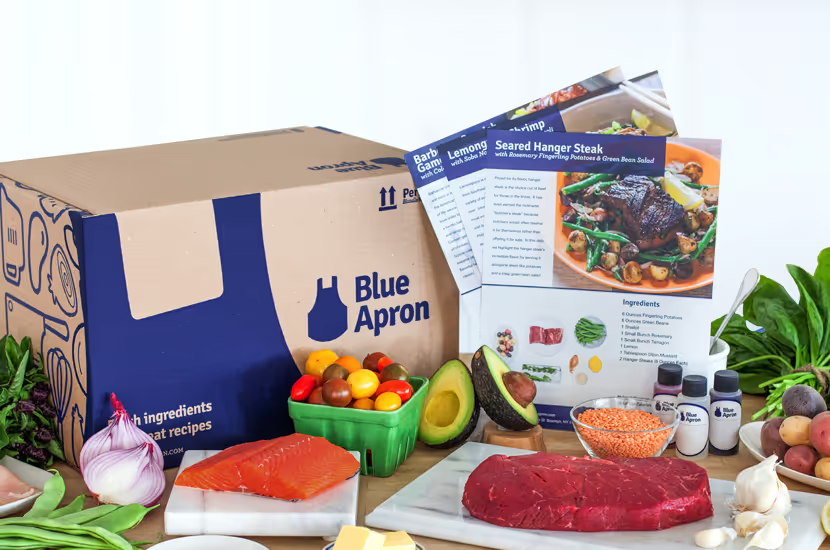
As the company faces rising acquisition costs and increasing competition, the only way to keep from going under is to immediately reinforce the parts of the customer lifecycle that keep subscriptions active.
We’re going to show you why this acquisition addiction isn’t profitable, and finish with the retention strategies Blue Apron can use to increase a user’s lifetime revenue by at least $437 and gain traction on the path to profitability.
Table of Contents
- The Hidden Customer Churn Problem and Why it Matters
- Inside Blue Apron’s Customer Retention Problem
- Blue Apron’s Economic Imbalance: The Numbers
- Blue Apron’s “Growth” Strategies: How did they get here?
- A Solution to the Problem: Our Recommendations & Impact
The hidden customer churn problem and why it matters
While subscription meal-kits seemed like the perfect way to encourage convenient at-home cooking, none of them have found the “recipe for success”. Each major player in the industry suffers from unsustainable churn rates, estimated by analysts to be upwards of 70% after 12 months.
Included in the graph below for comparison are subscription services Dollar Shave Club and Netflix.
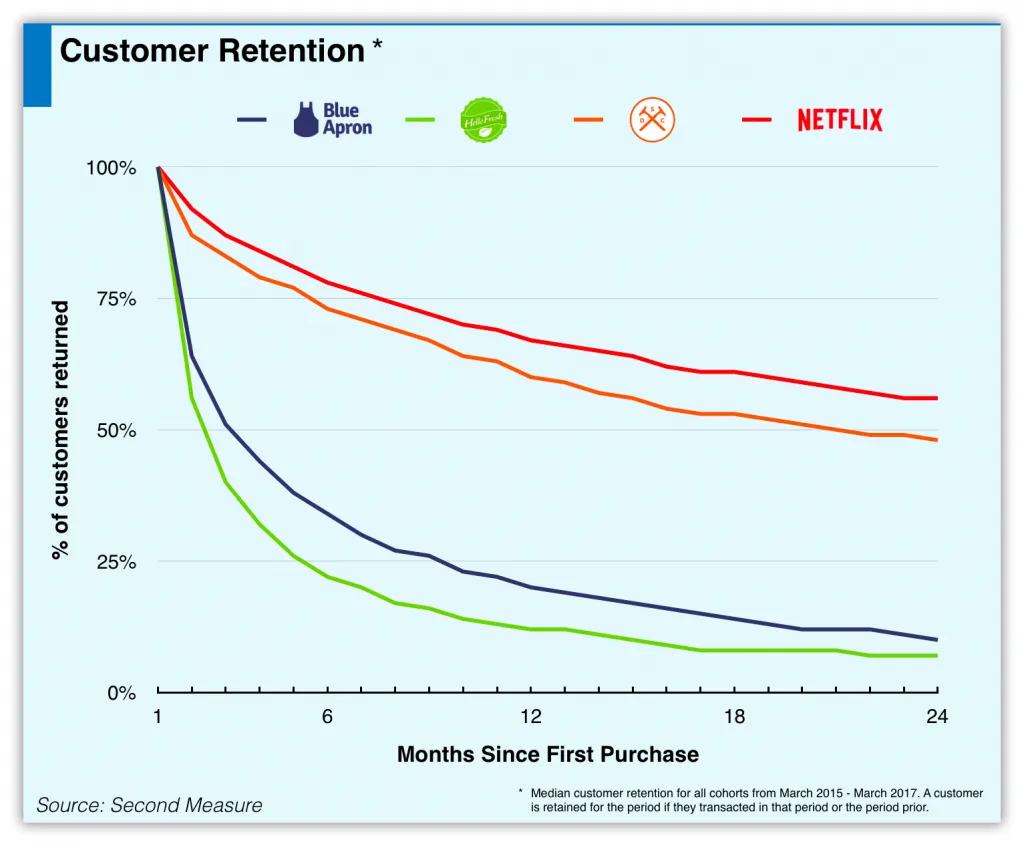
For companies like Blue Apron, customers capitalize on introductory offers only to cancel before a payment is required. While acquisition offers are a popular tactic to lower the risk of committing to a recurring payment, they aren’t enough to drive repeat usage.
But don’t just take our word for it.
“I used blue apron since I was getting $20 off 3 boxes. As soon as I stopped getting it I cancelled and within a week I got emailed another promo code to come back for two weeks. Did that and cancelled again and now I have another promo code that is good for another 3 weeks.
I’m basically just paying $40 cause at that price its worth it with no intention of every paying the full $60. How the heck is this company still in business” – Reddit user
A marketing professor at Emory University estimates that the company is losing money on about 70% of its customers because it spends too much to drive acquisition only for customers to cancel too soon.
This inability to create and retain a loyal customer base prevents brands like Blue Apron from turning a profit, since offering anything on a subscription basis makes retention one of, if not the most important metric.
Why retention is the driver of profit
A subscription-based product will only make a profit if a customer’s lifetime value (LTV) exceeds the money spent to acquire them (CAC). When LTV is determined by how long their subscription stays active, the company must keep the relationship alive until at least CAC is earned back.
This isn’t like an on-demand service where a customer is expected to make another purchase in a couple of days or weeks. For meal-kit subscriptions, a canceled customer isn’t spending any money at all, leaving the company at a loss if the LTV didn’t exceed CAC.
Our analysis going forward will focus on what Blue Apron can do to increase its customer’s LTV and start the path to profitability.
Inside Blue Apron’s customer retention problem
Blue Apron was founded in 2012 with the goal of “help[ing] households nationwide experience the joy of culinary experiences at home through [its] meal, wine and marketplace offerings”.
The business model is based on a promise of convenience – a Blue Apron box is shipped to your door, containing the exact ingredients you need to cook and assemble a gourmet meal for your or your family.

In 2015, after just 3.5 years of operation, the company reached a $2 billion valuation. But two years later, that valuation sank to $120 million. Contributing factors include the acquisition of Whole Foods by Amazon threatening to cut into their marketing share, skepticism from investors, and leadership changes.
June 2017 also saw its initial public offering, priced at $10/share. Stock price continued to drop until the company risked being delisted from the NYSE as its closing share price dipped below $1.00.
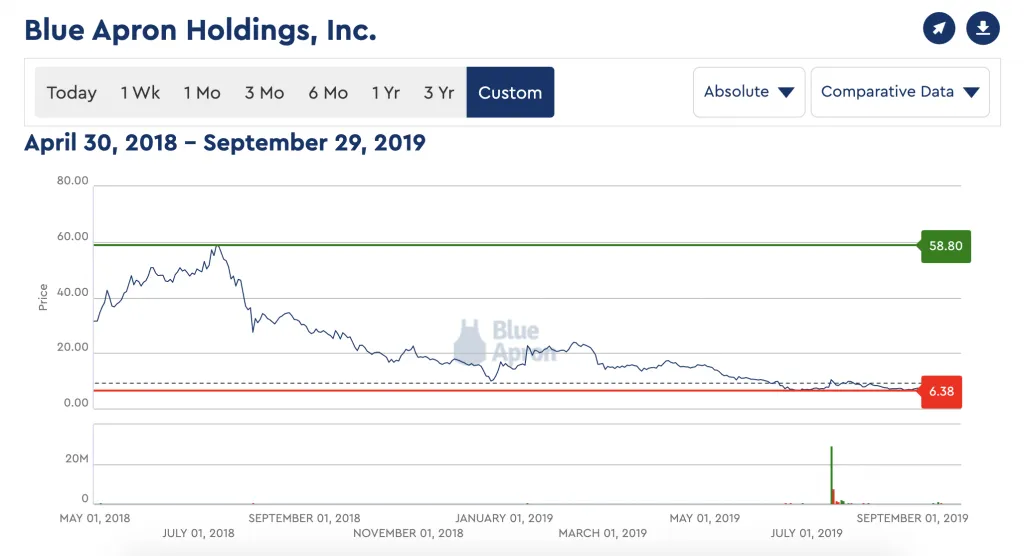
However, a declining share price isn’t to blame for Blue Apron’s retention issues. Blue Apron going public revealed a larger problem than anyone thought, which is the result of business operations taking place well before and after the IPO.
Share price aside, in the first quarter of 2019, the company posted a net loss of $5.3 million, having incurred net losses every year since inception. While losses were narrower in the second quarter, it hasn’t been enough to break even.
The story of Blue Apron is now characterized by rising costs, a nose-diving stock, declining marketing efficiency, consistent losses, and the inability to keep up with the competition or retain enough customers.
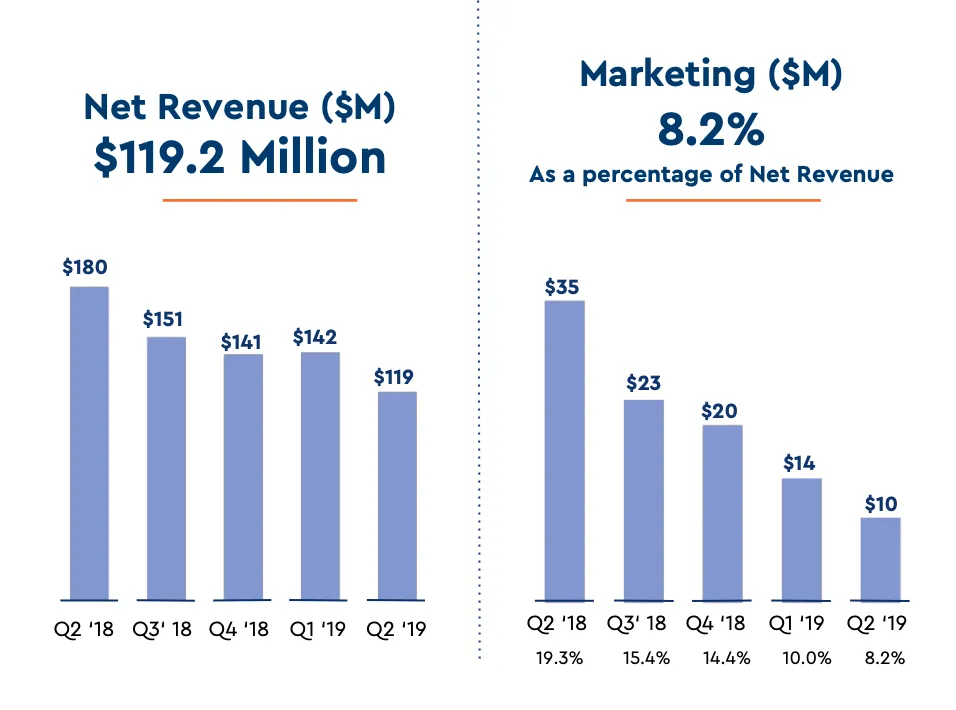
Blue Apron’s Economic Imbalance: The numbers
Customer Acquisition Cost (CAC): Blue Apron says its CAC was $94 between 2014 and 2016. Its cost to acquire a customer is a combination of advertising expenses plus however many free or discounted meals a new customer gets through welcome offers.
However, based on an increased marketing spend in recent years, analysts estimate that the company’s CAC is anywhere from $150 to over $400 per new customer.
For example, one analyst notes that between March 2016 and March 2017, the company added 387k new customers and spent $179M in marketing. While this may be inflated without taking into account every relevant metric, this would indicate a CAC of ~$460 — or at least greater than the $94 quoted by the company.
Churn: Churn and retention rates are also not officially provided by Blue Apron. However, multiple sources (here and here) suggest that after six months, 72% of customers have churned, while only 28% are retained. After one year, about 18% of customers remain.
Other sources cite even more extreme churn rates. Insights from 1010data state that 50% of Blue Apron customer churn after the second week, and that Blue Apron’s retention rate drops to 20% after 11 months and just 10% after 24 months.
Blue Apron says this is inaccurate, but doesn’t provide official data stating otherwise.
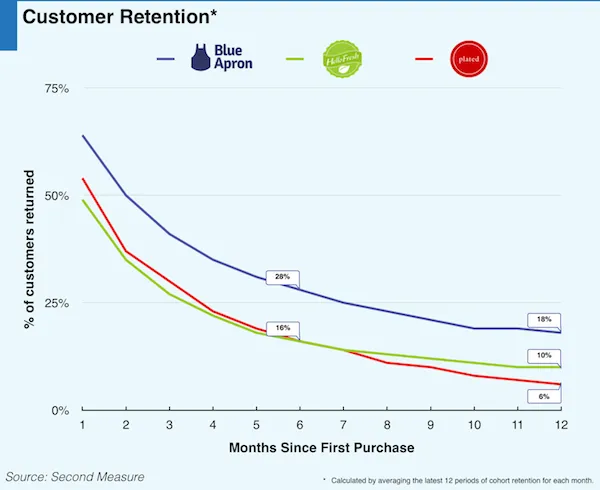
Lifetime Value (LTV): Undoubtedly an important metric for a subscription business, Blue Apron still doesn’t officially indicate the health of its LTV.
However, using numbers from the five most recently-recorded quarters (June 2018 – June 2019), Blue Apron’s average order value is $57.50, and the average customer is making 4.4 orders per quarter.

Given that the company’s gross profit margin has averaged 33% over the past 5 years, Blue Apron makes approximately $19 per order.
With this information, we can explore how many orders per customer (OpC) would need to be placed to drive profit given moderate, and extreme CAC values, using a consistent order gross profit margin value of $19.

In simplistic terms, for Blue Apron to make a profit after acquiring a customer at a moderate acquisition cost of $150, each customer would need to make at least 8 orders. To reach a positive LTV:CAC ratio at the extreme acquisition cost of $400, a customer must make at least 22 orders.
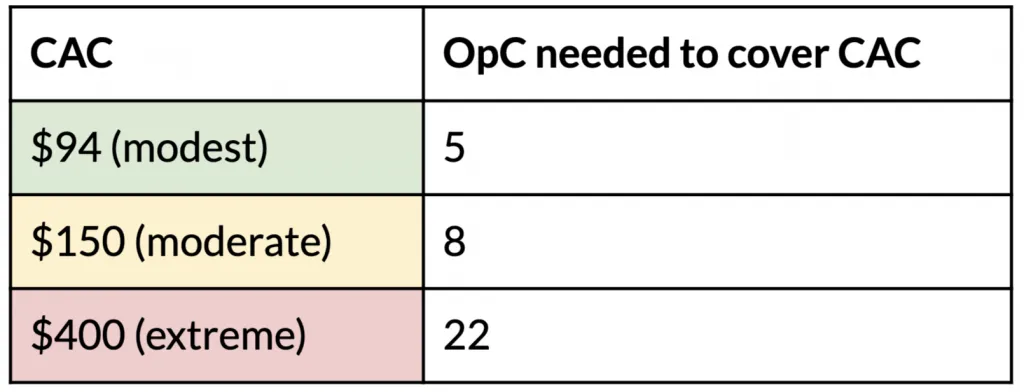
If a customer makes an average of 4.4 orders every three months, this means they would need to stick around for at least six months. But as noted from Blue Apron’s speculated churn rates, most customers don’t make it to that point:
- After 3 months, only ~40% of customers remain
- After 6 months, only 28% of customers remain
- After 1 year, only 18% of customers remain
Blue Apron is a great example of how when a customer’s lifetime value does not exceed the cost to acquire them, it’s impossible for a company to make a profit.
How did the company get into this tricky situation?
Blue Apron’s “Growth” Strategies: How did they get here?
Despite Blue Apron’s unwillingness to provide definite LTV and CAC data, the company’s actions speak for themselves.
Let’s start by looking at growth strategies.
Customer Acquisition Strategies
1. Referral programs: Existing Blue Apron customers can send free meals to their friends.
2. Influencer programs: YouTubers and podcast creators can be seen and heard promoting Blue Apron meals and demonstrating how it works.
3. Affiliate programs: Official Blue Apron affiliates can earn up to $15 for each new subscription sale that they drive.
4. Welcome offers: New visitors to the Blue Apron website can qualify for $50 off their first box, or be gifted $30 a credit if they don’t complete the checkout process.
5. Partnerships: Blue Apron has partnered with Weight Watchers, Costco, Jet, and celebrity chefs in attempts to leverage new acquisition channels and get their brand “in front of multiple customers at a time”.
Customer Retention Strategies
1. Win back emails: After a user cancels their subscription, they receive a generic email to reactivate and get $30 off their next delivery. The success of these win-back campaigns is unknown, though we can see how it would be enticing for certain users.
As you can see from these lists, Blue Apron is acquisition-heavy with its growth initiatives. All new strategies are in an effort to attract more customers instead of keeping the ones that it already has.
There’s nothing inherently wrong with these acquisition strategies, but there’s danger in making it your only strategy for growth. When retention is the bigger piece of the profitability puzzle for a subscription business, Blue Apron can’t afford to ignore it.
This begs the question: Why isn’t Blue Apron doing more to focus on customer retention when it seems like an obvious path to profitability?
While we can’t know for sure, it’s easy for companies to become acquisition-addicted when:
- It’s more gratifying to get “more new” customers,
- Retention strategies are considered too difficult,
- Investors are overly concerned with acquisition data, or
- The company simply doesn’t know how to retain customers.
It certainly feels like acquisition has always been the priority of leadership. In the Q2 earnings call in 2018, former CEO Brad Dickerson stated:
“[On] marketing efficiency and retention, the challenge for us, we believe is more on the acquisition side of the business, not on the retention side of the business. If we can acquire customers in an efficient manner, the retention side of the business shouldn’t be a challenge for us as much.” (source)
But acquisition doesn’t equal retention.
The company’s main mission should be to extend every customer’s subscription as long as possible, instead of assuming that acquisition strategies double as a retention tool.
Later on, it looks like Blue Apron might have at least thought about retention, mentioning in the 2018 Q3 earnings call that the company would like to explore “spend[ing] more promotional dollars further down the lifecycle funnel and not just spending them at the very top of the funnel, and looking at loyalty programs.”
But even as Blue Apron customers have noticed, this initiative has materialized, so we’re here to help.
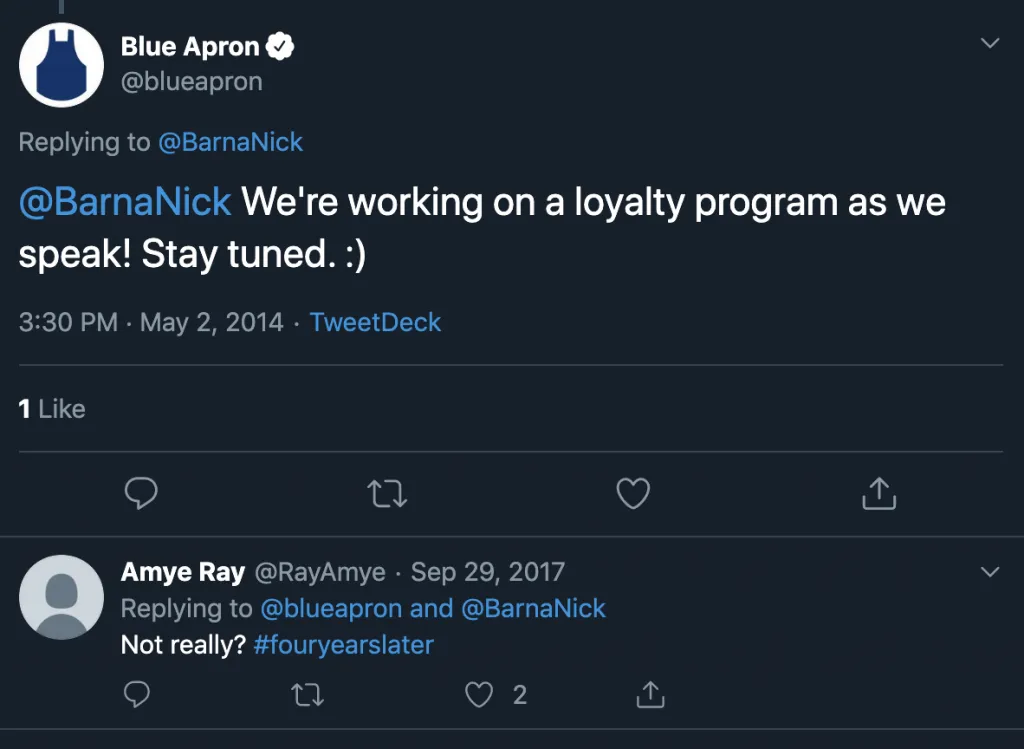
A solution to the problem: Our Recommendations
Why are customers canceling?
The top reason why customers stop using a meal kit delivery service is because they don’t feel like they’re getting enough value for their money.
The term “adding value” gets tossed around the marketing world with a lot of ambiguity. In this case, it simply means that customers aren’t convinced that Blue Apron is something they should continue spending money on, considering the amount of free offers from competitors (ie. Hello Fresh) and easy alternatives (ie. buying your own groceries).
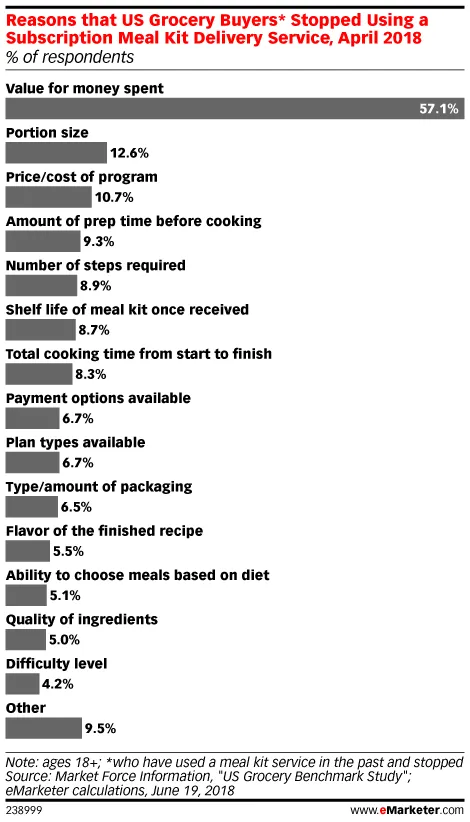
The solution: A complete lifecycle approach
To address this, Blue Apron must tend to the parts of the customer lifecycle where customers are mostly likely to start questioning if it’s worth the money.
To illustrate, every company has an ideal customer journey. For a subscription service, it looks like this:
Customer tries service → customer understands value of paying for service → customer continues subscription (customer may cancel and reactivate subscription) → customer refers friends to become subscribers.
Being a product intended for repeatable use, subscription services like Blue Apron fall short when no one sees the value in continuing the subscription. Blue Apron’s (non-ideal) current customer journey looks like this:
Customer tries service → customer cancels subscription.
You don’t need to be an analyst to realize that’s not going to work.
Blue Apron’s main weakness is in its ability to expose customers to its product long enough to effectively communicate the value, moving them from the trial stage to continued usage.
Addressing this means optimizing every stage of the customer lifecycle — not just acquisition.
We’re using AARRR metrics to show how Blue Apron’s customer lifecycle is currently laid out, with related rewards and incentives to motivate optimal customer behavior:
| Customer lifecycle stage | What success looks like at this stage |
Blue Apron’s current incentive to motivate this |
| Acquisition | Customers sign up for a Blue Apron subscription (discounted or at full price). | Free/discounted box offers |
| Activation | Customers start to realize the value of receiving a Blue Apron box each week and are getting hooked on the value it brings. | N/A (Blue Apron sends newsletters with meal suggestions and new products) |
| Revenue
(optimization) |
Customers spend more money by taking advantage of Blue Apron’s additional offerings and making more frequent orders. | N/A (Blue Apron sends newsletters with meal suggestions and new products) |
| Retention | A customer has cancelled their subscription or skipped a significant amount of orders and is re-activated. | Win-back incentive via email ($30 off next box) |
| Referral | A customer invites their friends, family, colleagues and social network to try Blue Apron. | N/A Customer referral program does not provide an incentive to the existing customer. |
Download a PDF copy of this table by clicking here.
Blue Apron needs to deliberately design their offers around the parts of the lifecycle that are contributing to churn. While not everyone will complete the ideal journey, there are ways to encourage the best track possible.
Here’s what each stage of the lifecycle means for Blue Apron and how each should be addressed.
1 – Acquisition: How do you get customers to try your product for the first time?
As we’ve outlined throughout this article, Blue Apron has customer acquisition on lockdown. It represents the bulk of its marketing strategies.
Whether it’s $30 off your first order, two free meals, or a free box from a friend, Blue Apron pulls out all the stops to get users to try its service for the first time. The company also sends offers to those who start the signup process but don’t end up checking out.
When Blue Apron focuses on acquisition, it does yield more customers. When marketing spending went from $51 million in 2015 to $144 million in 2016, this resulted in twice as many customers by the end of 2016.
But for Blue Apron, acquisition doesn’t mean profit. The company admitted that “during 2016, 92% of [its] net revenue was generated from Repeat Orders”. Rarely does a customer’s first order drive any substantial revenue, as it’s likely the result of a hefty discount.
Recommendation:
Acquisition is important for a product that is still relatively new, and that asks for a recurring financial commitment. While Blue Apron shouldn’t drop its acquisition efforts, we’ll explain how it’s worth spreading its marketing budget amongst retention and revenue optimization if it wants to see a profit.
2 – Activation: How do you get customers to realize the value of your product?
Activation is one of the most important customer lifecycle stages for Blue Apron to master.
It’s where it must answer every customer’s question after they’ve exhausted their welcome offers and free boxes: Why should I pay for a subscription to Blue Apron instead of switching to a competitor or just buying my own groceries?
Blue Apron believes that giving away a few free or discounted boxes is enough to turn users into loyal customers. But the company seems to have missed the mark in knowing what it takes for a customer to fully realize the value that it provides.
Getting customers hooked means figuring out the brand’s unique activation event.
A successful customer “activation” is when they use your service enough and in the right ways to realize the true usefulness of it — this is often referred to as the customer’s “aha moment” or “activation event”.
By leveraging historical data and monitoring customer behavior, brands can identify the customer action that, when completed, typically leads to product or service adoption. For example:
- Dropbox: After creating a Dropbox account, you’re prompted to upload your first file. This was determined their best indicator as to whether someone would come back to use the service again.
- Twitter: When you create a new account, you’re encouraged to follow popular or relevant accounts. Twitter found that if they couldn’t encourage a new user to follow 30 other people, that user was likely to never come back.
- Facebook: When you sign up for Facebook, you’re asked to add friends. The team found that a user who added 7 friends within the first 10 days in the app was more likely to remain a long-term user.
For Blue Apron, the “aha” moment likely comes down to how many orders a customer must place before they start to incorporate consistent deliveries into their everyday life.
Recommendation:
Offers and incentives must carry forward into the activation stage. For example, a customer might earn:
- One free box of meals after every three orders
- A free bottle of wine with every 5th order
- 1 point for every dollar spent to redeem on the cost of a future box or meal upgrade
Blue Apron must motivate customers to remain subscribed at least until the activation threshold is met by associating every purchase with a positive reinforcer (ie. progress towards a free box, additional credit, free perks).
Blue Apron knows that their top 30% of customers account for more than 80% of net revenue, and have 10x the average revenue when compared to other customers. The company can look to the journeys and behaviors of this segment to understand what actions lead to product commitment.
In addition, the company can pair its incentives with increased visibility into the value customers are getting. For example, banking apps do a great job at showing how much a customer has saved in fees since signing up. Blue Apron can borrow this model to show a customer how much time they’ve saved, how many trips to the grocery store they’ve been able to avoid, or how far they’ve expanded their culinary skills since becoming a subscriber.
3 – Revenue: How do you get customers to keep contributing to your bottom line?
Once the company has successfully activated a customer, the next goal is to keep them as paying customers by up-selling and cross-selling to optimize revenue.
As customers start incorporating Blue Apron deliveries into their daily routines, the company must add extra value that strengthens a customer’s resistance to cancel. In other words, Blue Apron needs to convince customers that they’ll be worse off if they choose to cancel by giving them something to lose.
We know from human psychology that we’re wired to avoid loss. In fact, the pain we feel from loss is about twice as powerful as the pleasure of gaining. Marketers know how to take advantage of this by increasing switching costs.
Recommendation:
The Blue Apron customer who places 20 orders receives no extra benefit than the customer who places 3, so they lose nothing by canceling and jumping to the next best alternative.
This is where incremental rewards (like tiered VIP programs) come into play. The more purchases you make, the better rewards you unlock. Whether customers earn an elevated social status, points to be redeemed for marketplace items or meals, free shipping, or early access to try new recipes, Blue Apron must make it clear that spending = earning, and canceling = abandoning your accrued progress, rewards, access, and privileges.
By giving customers something to lose if they switch brands, FOMO kicks in and increases the chances that they stick with you over time. The ultimate customer lifetime value is achieved when your product becomes something they don’t want to live without.
4 – Retention: How do you win back customers if they have canceled?
If a customer cancels their subscription, Blue Apron sends two emails, two days apart, encouraging them to re-activate for $30 off their next order. It’s not cited how effective these emails are, but the company does a good job of leveraging incentives for re-activation.
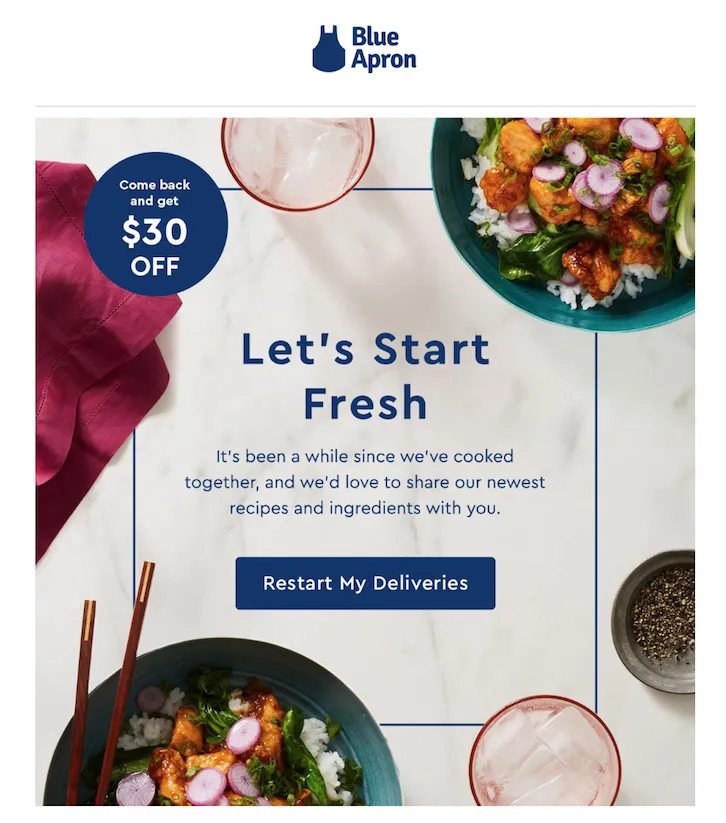
However, it’s Blue Apron’s current cancellation policy that is sabotaging any chance of these emails being successful.
For a Blue Apron customer to cancel their subscription, they need to write and send an email to the company’s customer care team, who will then provide them with a link to their cancellation page.
Customers have taken to Reddit to explain that it didn’t use to be that way, but instead was done through a simple cancel button – as it should be. This gives the impression that the company is desperate to extend subscriptions just a little bit longer, in the hopes that the complicated process will squeeze a few more orders out of each customer.
Not only does this impair the success of any retention efforts, but has caused past customers to take back their willingness to refer anyone to Blue Apron:
“I actually recommended blue apron to several of my friends. I’m going to be going to them and taking that recommendation back and, rest assured, next time a service like this comes up in conversation, I’ll spread the word that your site is designed to make cancellations difficult and that peoples’ money is best spent elsewhere”. (source)
Recommendation:
Blue Apron should keep supporting its retention efforts with incentives, given that once a customer cancels, their lifetime value stops adding up. If that LTV didn’t exceed the customer acquisition cost, Blue Apron is left with a loss.
However, their cancellation policy must be re-designed to keep customer relationships on good terms. It’s hard to have faith in a product that purposefully makes it difficult to end the subscription.
5 – Referral: How do you drive word-of-mouth marketing?
Blue Apron’s customer referral program lets existing customers invite others to receive a complimentary meal delivery, and it works:
“Of our Customers for the first quarter of 2017, 34% were acquired through our customer referral program” – S1 Filing
The referral program is doing its job but, once again, mostly as far as acquisition is concerned.
A customer referral program is an excellent strategy for Blue Apron to leverage, as we know that 92% of consumers trust recommendations from family and friends above all other forms of advertising, and people are 4 times more likely to buy when referred by a friend. (Neilsen)
However, Blue Apron’s program is single-sided: As an existing customer, your friend receives a free meal, but you don’t get anything in return.
Recommendation:
Blue Apron can significantly increase the performance of their program and leverage it as a retention tool by instead offering a double-sided referral program where both the referring AND referred user receives an incentive:
- “Give $30 get $30 when you invite a friend”
- “Send a free meal to your friend and get free shipping on your next order”
- “Treat your friends to a free meal and get 10% off your next order”
While a double-sided referral program requires a larger investment, you directly appeal to an existing customer’s willingness to refer, and prevent them from feeling like a salesperson for your brand.
Plus, many users aren’t motivated to profit off their own networks. When it’s clear that both users benefit, both the new and existing users are on a level playing field and feel better about initiating/accepting the offer.
Successful companies like Uber, Airbnb, and Dropbox all use double-sided referral programs to grow their customer base and retain loyal users. Even direct Blue Apron competitor Hello Fresh runs a double-sided referral program where both the new and existing customers receive a $50 credit on their account.
Blue Apron Customer Lifecycle with Recommendations
| Customer lifecycle stage | What success looks like at this stage | Recommended incentive to motivate this | Why this works |
| Acquisition | Customers sign up for a Blue Apron subscription (discounted or full price). | Free/discounted box offers. | New users require an incentive to lower the risk of trying a new product for the first time — especially one asking for a recurring commitment. |
| Activation | Customers start to realize the value of receiving a Blue Apron box each week and are getting hooked on the value it brings. | Usage goals to earn rewards (ie. buy 3 boxes get one free). | Cooking from a Blue Apron box a few times is not enough for a customer to realize the value of incorporating it into their daily lives. Customers must be encouraged to meet the activation threshold. |
| Revenue (optimization) | Customers spend more money by taking advantage of Blue Apron’s additional offerings and making more frequent orders. | Accrued rewards that increase the value of being a customer over time (ie. reward tiers based on prolonged usage). | Once a paying customer, users need a
reason to extend their subscription for an optimal lifetime value that exceeds CAC. This is the only way Blue Apron will make a profit. |
| Retention | A customer has canceled their subscription or skipped a significant amount of orders and needs to be re-activated. | Win-back offer to entice re-activation (ie. $$ off, free shipping, free gift). | Even if a customer has canceled, you still have a 60-70% chance of success to sell to them again, and remind them of the value they’re missing out on. |
| Referral | A customer invites their friends, family, colleagues and social network to try Blue Apron. | Customer referral program with rewards (ie. $$ off) for both new and existing customers. | With both parties on a level playing field, existing customers will be more likely to refer, and new users will feel better about accepting offers. |
Download a PDF copy of this table by clicking here.
Impact of recommendations
If our recommendations increase the average amount of orders per customer from 4.4 per quarter to 12 (ie. one order every week for 3 months), with an average (gross profit margin) order value of $19 this means that customer LTV will increase from $84 to $228 — a difference of $144. Before taking into account the gross profit margin, this is a difference of $437 in revenue per customer.
While this still does not yield a positive LTV:CAC ratio at the extreme customer acquisition cost, Blue Apron’s customer acquisition costs should not be as high if the company redirects a large share of marketing expenses to retention efforts.
We all know that it’s 5-25x cheaper to retain an existing customer than to acquire a new one.

The biggest takeaway for a service like Blue Apron is that acquisition does not equal retention. When customers face an endless amount of alternatives, you must purposefully engage them where they are most likely to drop off.
By reinforcing the parts of the customer lifecycle that are currently contributing to aggressive churn, Blue Apron can ensure that more and more customers follow their ideal subscriber journey.
Final Thoughts
Blue Apron is a great example of how too many companies dangerously see “growth” as “get more new customers” rather than “maximize value from existing customers”.
While customer acquisition may be straightforward, gratifying, and look great on paper, it can quickly become a surefire way to stunt corporate growth instead of fueling it.
If you’re from Blue Apron, we’d love to chat with you and explore how we can help implement these changes to get your business back on track to profitability.
If you’re operating a subscription service facing similar challenges, we invite you to explore how a software platform like SaaSquatch can address retention.
If you have any comments, please tweet us with your thoughts.